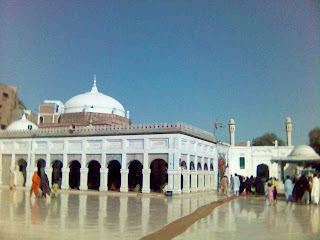One of Farīd’s most important contributions to Punjabi literature was his development of the language for literary purposes. Whereas Sanskrit, Arabic, Turkish and Persian had historically been considered the languages of the learned and the elite, and used in monastic centres, Punjabi was generally considered a less refined folk language. Although earlier poets had written in a primitive Punjabi, before Farīd there was little in Punjabi literature apart from traditional and anonymous ballads. By using Punjabi as the language of poetry, Farīd laid the basis for a vernacular Punjabi literature that would be developed later.
Among the famous people who have visited his shrine over the centuries are the famous scholar-explorer Ibn Battuta, who visited in 1334,[12] and the Founder of Sikhism, Guru Nanak Dev, who met the then head of the shrine, Sheikh Ibrāhīm, twice, and his meeting led to the incorporation of 112 couplets (saloks) and four hymns by Bābā Farid, in the Sikh Holy Book, the Guru Granth Sahib, by the fifth Guru, Arjan Dev in 1604.[4] Guru Nanak was familiar with the verse of Bābā Farīd, and not only includes these verses in the Holy Book, but even comments on some of them.[13] These verses are known to the Sikhs as the Farīd-Bānī; Guru Arjan Dev also added eighteen saloks from the Sikh Gurus, which add commentary to various of Bābā Farīd's work.[13]
The city of Faridkot bears his name. According to legend, Farīd stopped by the city, then named Mokhalpūr, and sat in seclusion for forty days near the fort of King Mokhal. The king was said to be so impressed by his presence that he named the city after Bābā Farīd, which today is known as Tilla Bābā Farīd. The festival Bābā Sheikh Farād Āgman Purb Melā' is celebrated in September each year, commemorating his arrival in the city.[14][15] Ajodhan[11] was also renamed as Farīd's 'Pāk Pattan', meaning 'Holy Ferry'; today it is generally called Pāk Pattan Sharīf.[12]
Faridia Islamic University, a religious madrassa in Sahiwal, Punjab, Pakistan, is named after him,[16] and in July 1998, the Punjab Government in India established the Baba Farid University of Health Sciences at Faridkot, the city which itself was named after him.[17][18]
Various accounts are related as to why Bābā Farīd was given the title Shakar Ganj[19] ('Treasure of Sugar'). One legend tells how his mother used to encourage the young Farīd to pray by placing sugar under his prayer mat. Once, when she forgot, the young Farīd found the sugar anyway, an experience that gave him more spiritual fervour and led to his being given the name.[4]
Other accounts and legends also says that Baba Farid once a caught a bolt of lightning with his bare hands and placed it into a pot, which saved the lives of many civilians.
Tomb:
The small tomb of Baba Farid is made of white marble with two doors, one facing east and called the Nūrī Darwāza or 'Gate of Light', and the second facing north called Bahishtī Darwāza, or 'Gate of Paradise'. There is also a long covered corridor. Inside the tomb are two white marbled graves. One is Baba Farid's, and the other is his elder son's. These graves are always covered by sheets of cloth called Chadders (the green coloured chadders are covered with Islamic verses), and flowers that are brought by visitors. The space inside the tomb is limited; not more than ten people can be inside at one time. Ladies are not allowed inside the tomb, but the late Benazir Bhutto, then prime minister of Pakistan, managed to enter inside when she visited the shrine.
Shrine:
The Shrine (mazar/mazār) is vast and spacious, located in the city of Pakpattan, otherwise Pākpattan Sharīf. At first his tomb and shrine were constructed under the supervision of Saint Nizamuddin Auliya/Khawaja Nizamuddin Aulia. The shrine is made entirely of marble. Some years back it was partly made of marble and bricks. Charity food called Langar is distributed all day by visitors and the Auqaf Department, which administrates the shrine. The shrine is open all day and night for visitors. The shrine has its own huge electricity generator that is used whenever there is power cut or loadshedding, so the shrine remains bright all night, all year round. There is no separation of male and female areas but a small female area is also there. There is a big new mosque in the shrine. Thousands of people daily visit the shrine for their wishes and unresolvable matters; for this they vow to give to some charity when their wishes or problems are resolved. When their matters are solved they bring charity food for visitors and the poor, and drop money in big money boxes that are kept for this purpose. This money is collected by the Auqaf Department that looks after the shrine.
On October 25, 2010, a bomb exploded outside the gates of the shrine, killing six people.




